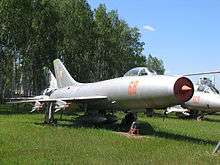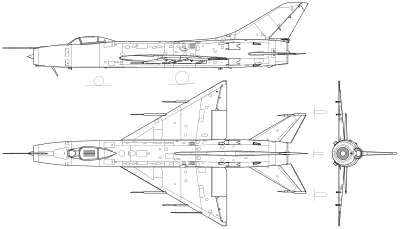Sukhoi Su-9
The Sukhoi Su-9 (NATO reporting name: Fishpot) was a single-engine, all-weather, missile-armed interceptor aircraft developed by the Soviet Union.
| Su-9 | |
|---|---|
 | |
| Three Su-9 aircraft | |
| Role | Interceptor aircraft |
| National origin | Soviet Union |
| Manufacturer | Sukhoi |
| First flight | 24 June 1956 |
| Introduction | 1959 |
| Retired | 1970s |
| Primary user | Soviet Air Defense Forces |
| Number built | 1,150 |
| Variants | Sukhoi Su-11 |
Development
The Su-9 emerged from aerodynamic studies by TsAGI, the Soviet aerodynamic center, during the Korean War, which devised several optimum aerodynamic configurations for jet fighters. The design first flew in 1956 as the T-405 prototype. The Su-9 was developed at the same time as the Su-7 "Fitter", and both were first seen by the West at the Tushino Aviation Day on 24 June 1956, where the Su-9 was dubbed Fitter-B. It entered service in 1959.
Total production of the Su-9 was about 1,100 aircraft. It is believed that at least some Su-9s were upgraded to Su-11 "Fishpot-C" form. None were exported to any of the USSR's client states nor to the Warsaw Pact nations. Remaining Su-9s and later Su-11s were retired during the 1970s. Some were retained as test vehicles or converted to remote-piloted vehicles for use as unmanned aerial vehicles. It was replaced by the upgraded Su-11 and the much-superior Su-15 "Flagon" and MiG-25 "Foxbat".
The combat record of the "Fishpot", if any, is unknown. It is possible that it was involved in the interception (or even shoot-down) of reconnaissance missions whose details remain classified, but nothing is publicly admitted.
It was reported that a Su-9 was involved in the interception of Francis Gary Powers' U-2 on Soviet territory on 1 May 1960. A newly manufactured Su-9 which was in transit flight happened to be near Powers' U-2. The Su-9 was unarmed and was directed to ram the U-2. One ramming attempt was made and the Su-9 missed the U-2, primarily due to large difference in the speed of the two planes. No further ramming attempt was made due to Su-9's lack of fuel. Its pilot, Captain Igor Mentyukov later claimed that his slipstream had caused the U-2 to break apart. He discounts the official version that the U-2 was shot down by an SA-2 missile, saying that Captain Powers could not have survived such a hit.
On September 4, 1959 a modified Su-9 (designated T-431 by the bureau) piloted by Vladimir Sergeievitch Ilyushin set a new world record for absolute height, at 28,852 m (94,658 ft). In November of the same year Ilyushin set several new sustained speed/altitude records in the same aircraft. This record was later broken on 6 December 1959 by Commander Lawrence E. Flint, Jr., who performed a zoom climb to a world record of 98,557 ft (30,040 m) while piloting an F4H-1 Phantom.[1]
Design

The Su-9's fuselage and tail surfaces resembled those of the Su-7, but unlike the swept wing of that aircraft, the "Fishpot" used a 53° delta wing with conventional slab tailplanes. It shared Sukhoi features like the rear-fuselage air brakes as well as the Su-7's Lyulka AL-7 turbojet engine and nose intake. The translating shock cone contains the radar set.
The Su-9 was developed from earlier work on a developmental aircraft designated T-3, to which the Su-9 was very nearly identical. Internally at Sukhoi, the Su-9 was known as the T-43.
The delta wing of the Su-9 was adopted because of its lower drag in the supersonic flight regime. Its greater volume also allowed a very modest increase in fuel capacity compared to the Su-7. The Su-9 was capable of Mach 1.8 at altitude, or about Mach 1.14 with missiles. Its fuel fraction remained minimal, however, and operational radius was limited. Furthermore, rotation speeds were even higher than the Su-7, which was already high at 360 km/h (225 mph). Unlike the Su-7, which had very heavy controls but docile handling characteristics, the "Fishpot" had light and responsive controls, but was very unforgiving of pilot error.
The Su-9 had primitive R1L (NATO reporting name "High Fix") radar in the shock cone and was armed with four K-5 (AA-1 "Alkali") beam-riding air-to-air missiles. Like all beam-riders, the K-5 was so limited as to be nearly useless for air-to-air combat . Unlike the Su-7 and later Su-15, no Su-9 carried cannon armament, although two fuselage pylons were reserved for the carriage of drop tanks.
A two-seat trainer version, designated Su-9U, was also produced in limited numbers (about 50 aircraft). It received the NATO reporting name "Maiden". It had a full armament and radar system with displays in both cockpits, allowing trainees to practice all aspects of the interception mission, but because the second seat further reduced the already meager fuel fraction, it was not truly combat-capable.
The Su-9 has been frequently mistaken for the MiG-21 due to the many similarities in design. The primary distinguishing factors are size and the Su-9's bubble canopy.
Variants
- T-405
- Prototype of the Su-9.
- Su-9
- Main production version, about 1,100 built.
- Su-9U
- Training version, armed and equipped with all operational systems but not fully combat ready, about 50 built.
- T-431
- Su-9 modified for setting of the world record for absolute height in 1962.
- Sukhoi Su-11
- Development of the Su-9.
Specifications (Su-9)

Data from OKB Sukhoi : a history of the design bureau and its aircraft[3]
General characteristics
- Crew: 1 (Su-9U 2)
- Length: 16.772 m (55 ft 0 in)
- Wingspan: 8.536 m (28 ft 0 in)
- Height: 4.82 m (15 ft 10 in)
- Wing area: 34 m2 (370 sq ft)
- Empty weight: 7,675 kg (16,920 lb)
- Landing weight: 8,658 kg (19,088 lb)
- Gross weight: 10,755 kg (23,711 lb)
- Max takeoff weight: 12,512 kg (27,584 lb)
- Fuel capacity: 3,100 kg (6,834 lb) internal + 2,160 kg (4,762 lb) in external tanks
- Powerplant: × Lyulka AL-7F-1-100 afterburning turbojet engine, 66.67 kN (14,987 lbf) thrust dry, 94.12 kN (21,158 lbf) with afterburner
Performance
- Maximum speed: 2,120 km/h (1,320 mph, 1,140 kn) / M1.73 at 13,000 m (42,651 ft)
- 2,230 km/h (1,390 mph; 1,200 kn) over 13,000 m (42,651 ft)
- Landing speed: 305–310 km/h (190–193 mph; 165–167 kn)
- Range: 1,350 km (840 mi, 730 nmi) internals
- Ferry range: 1,800 km (1,100 mi, 970 nmi) with external tanks
- Endurance: 1 hour 18 minutes on internal fuel
- 2 hours with external tanks
- Service ceiling: 20,000 m (66,000 ft)
- g limits: +7
- Wing loading: 316 kg/m2 (65 lb/sq ft)
- Thrust/weight: 0.89
- Landing run: 1,150–1,250 m (3,773–4,101 ft) without brake parachute
Armament
- Hardpoints: 2 x under-fuselage hardpoints for drop tanks and 4 x under-wing hardpoints for 500 kg (1,100 lb) of disposable stores[4] with provisions to carry combinations of:
- Missiles: 4 × K-5 air-to-air missiles
See also
Related development
Aircraft of comparable role, configuration and era
- English Electric Lightning
- Convair F-106 Delta Dart
- Lockheed F-104 Starfighter
- Dassault Mirage III
- Saab 35 Draken
- Mikoyan-Gurevich MiG-21
References
- MIchael Holm, http://www.ww2.dk/new/air%20force/regiment/iap/894iap.htm, accessed December 2012.
- Antonov, Vladimir; Gordon, Yefim; Gordyukov, Nikolai; Yakovlev, Vladimir; Zenkin, Vyacheslav; Carruth, Lenox; Miller, Jay (1996). OKB Sukhoi : a history of the design bureau and its aircraft (1st ed.). Earl Shilton: Midland Publishing. pp. 110–128. ISBN 9781857800128.
- www.3ebra.com, IT-Bureau Zebra -. "Sukhoi Company (JSC) - Airplanes - Museum - Su-9, 11, 13 - Specifications". www.sukhoi.org. Archived from the original on 2017-09-25. Retrieved 2017-09-25.
External links
| Wikimedia Commons has media related to Sukhoi Su-9. |